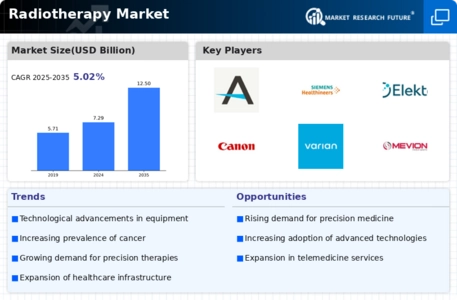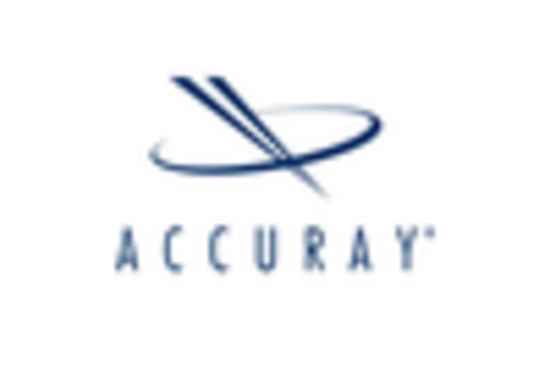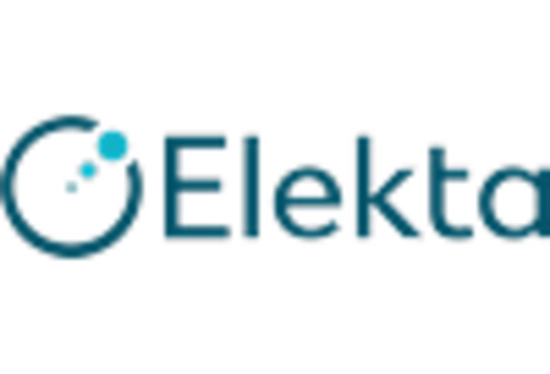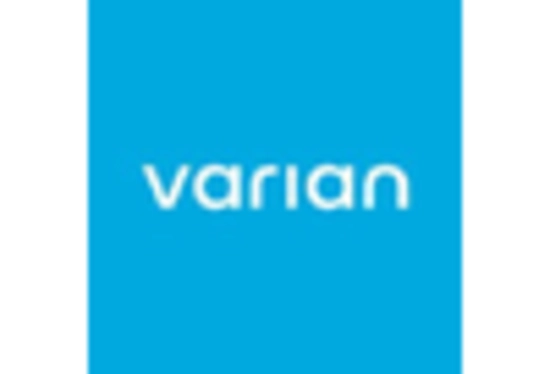The Radiotherapy Market is currently characterized by a dynamic competitive landscape, driven by technological advancements, increasing cancer prevalence, and a growing emphasis on personalized medicine. Major players such as Varian Medical Systems (US), Elekta AB (SE), and Siemens Healthineers (DE) are strategically positioned to leverage innovation and partnerships to enhance their market presence. Varian Medical Systems (US) focuses on integrating artificial intelligence into its treatment planning systems, which appears to enhance precision in radiotherapy. Meanwhile, Elekta AB (SE) emphasizes regional expansion, particularly in emerging markets, to capture a broader patient base. Siemens Healthineers (DE) is investing heavily in digital transformation, aiming to streamline operations and improve patient outcomes through advanced imaging technologies. Collectively, these strategies indicate a shift towards a more integrated and technologically advanced market environment.
In terms of business tactics, companies are increasingly localizing manufacturing to reduce costs and improve supply chain efficiency. The Radiotherapy Market is moderately fragmented, with several key players exerting considerable influence. This fragmentation allows for a diverse range of products and services, fostering competition that drives innovation. However, the presence of dominant players like Varian and Siemens suggests a competitive structure where collaboration and strategic partnerships are essential for sustained growth.
In August 2025, Varian Medical Systems (US) announced a partnership with a leading AI firm to develop next-generation treatment planning software. This collaboration is poised to enhance the accuracy and efficiency of radiotherapy treatments, potentially setting a new standard in the industry. The integration of AI into treatment planning not only streamlines workflows but also improves patient outcomes, indicating Varian's commitment to innovation.
In September 2025, Elekta AB (SE) launched a new line of compact linear accelerators designed for smaller healthcare facilities. This strategic move aims to democratize access to advanced radiotherapy technologies, particularly in underserved regions. By making high-quality treatment more accessible, Elekta positions itself as a leader in expanding the reach of radiotherapy services, which could significantly impact market dynamics.
In July 2025, Siemens Healthineers (DE) unveiled a comprehensive digital platform that integrates imaging and treatment data, facilitating a more holistic approach to patient care. This platform is expected to enhance collaboration among healthcare providers and improve treatment planning efficiency. Siemens' focus on digital solutions reflects a broader trend towards data-driven decision-making in healthcare, which is likely to shape future competitive strategies.
As of October 2025, the Radiotherapy Market is witnessing trends such as digitalization, sustainability, and the integration of artificial intelligence. Strategic alliances are increasingly shaping the competitive landscape, enabling companies to pool resources and expertise. The shift from price-based competition to a focus on innovation, technology, and supply chain reliability is evident. Moving forward, differentiation will likely hinge on the ability to deliver cutting-edge solutions that enhance patient care and operational efficiency.

















Leave a Comment